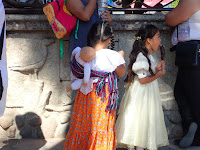Skipping a bit ahead to the NEXT
"novena," or 9-day series of fiestas.... (we are still working
out the dangerous fireworks story and pictures...!)
The novena celebrating Mexico's patroness
-- Nuestra Señora de Guadalupe! She
is a BIG deal in Mexico because she is the indigenous incarnation of
Mary.
Historical
Sidebar: The official story is that in 1531 a native Mexican peasant
called Juan Diego saw a vision of a
maiden at the Hill of Tepevac, which eventually became a suburb of Mexico City. She spoke to Juan Diego in his native Nahuatl, the language of the Aztecs, and asked for a
church to be built there in her honor.
Well, of course, Juan Diego went to
tell the priestly powers that be about this and they didn't believe him, since
he was only a Aztec indigenous peasant, after all.....3 times. The 4th day,
Juan Diego's uncle, Juan Bernardino, was deathly ill. Juan Diego went into town
to get a priest to say final rites, and took a different route to avoid wasting
time (?!) with The Lady.
She was a little offended by that, but
assured him that Juan Bernardino was now healed, and she told him to gather
flowers on the hill, which in December doesn’t usually have a lot of flowers
blooming. Juan found Castilian roses,
not native to Mexico, blooming. The Virgin arranged the flowers in Juan's cloak,
and when he opened his cloak for the archbishop on December 12, the flowers
fell to the floor, and on the fabric was the image of the Virgin of Guadalupe. They
built the church.
SO, you will see shrines to her ALL
over. On street corners, cars, etc. She is darker skinned, and her cloak has
the stars as they would have appeared in 1531.
 |
| One of our favorites in Ajijic |
So 9 days of the rockets (cohetes)
going off, and various fiestas, marches, and lots of masses.
The final day's big parade started at
6 Esquinas (6 corners) in Ajijic. We arrived, and after a while, a gringo lady
was looking at her watch and said somewhat petulantly "It was supposed to start at 4
o'clock." Linda just laughed and said "It's Mexico! the last parade
we saw started an hour and a half late!"
All the better to see all the cute
kids dressed up for the parade!
And watch all the different groups
lining up!
Ok, here we go! (Only 45 minutes
late!)
Drum corps was first
up, note the white sleeve "dingle balls" on their arms to
emphasize movement.
And the flag corps
And the Mayan dancers. (and yes,
there is always this much noise in a parade here!)
And the floats: 2 of Juan Diego and
the Lady of Guadelupe.
But our favorite part is the COHETES.
(You will hear most gringos complain about them, and we get that, particularly
if you live in Ajijic town where they have a LOT of them year round.)
Here's one of the 3 bundles of rockets
they had for this parade. We've heard that your prayers go up to God with the
cohetes, so you need a lot of them.
But this guy has the best job! We followed him for about a quarter mile
just watching him. Pretty sure he found us funny. "Cohete
Groupies!"
We wandered around town a bit and
walked over to the San Andres church, which was festively decorated.
Merry
Christmas & Happy Holidays everyone!




































